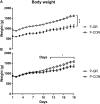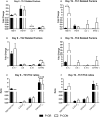Growth Restriction and Systemic Immune Development in Preterm Piglets
- PMID: 31649685
- PMCID: PMC6795705
- DOI: 10.3389/fimmu.2019.02402
Growth Restriction and Systemic Immune Development in Preterm Piglets
Abstract
Background: Many preterm infants are born with growth restriction (GR) following maternal or fetal complications before birth. Such infants may continue to grow slowly after birth, regardless of birth weight (BW), due to morbidities related to their immature organs. Severe GR increases the susceptibility to infections, but it is not clear if this is a consequence of impaired systemic immunity or other factors, such as prolonged hospital stay or poor mucosal barrier function. Using preterm pigs as models for preterm infants, we hypothesized that moderate GR, exerting limited clinical effects, does not influence systemic immune development. Methods: Preterm pigs were delivered by cesarean section and fed bovine milk diets until 19 d. Piglets with fetal growth restriction (F-GR, the lowest 25% of BW, n = 27, excluding those with BW <350 g) and postnatal growth restriction (P-GR, the lowest 25% of postnatal growth rate, n = 24) were compared with their corresponding controls (F-CON, n = 92, and P-CON, n = 85, respectively). Organ weights were determined and blood collected for assessment of clinical status (blood chemistry and hematology). For a subgroup (n = 58), in depth analyses of neutrophil function, T cell counts, plasma cytokine levels, and leucocyte gene expression were performed. Results: For F-GR pigs, adrenal gland weight was increased and bone mineral content decreased at 19 d. Total leucocyte levels were lower at birth and interleukin-10 levels increased at d 8-10. In P-GR pigs, total leucocyte, neutrophil, monocyte, and eosinophil counts along with helper T cell fractions were elevated at 8-19 d of age, while the fraction of neutrophils with phagocytic capacity was reduced. Diarrhea and all remaining organ weights, blood chemistry, and immune variables were not affected by F-GR or P-GR. Conclusion: Moderate GR before and after preterm birth has limited effect on systemic immune development in preterm pigs, despite marginal effects on immune cell populations, adrenocortical function, and body composition. Similar responses may be observed for preterm infants with moderate fetal and postnatal growth restriction.
Keywords: development; extrauterine; growth restriction; immune system; immunity; infant; intrauterine; preterm.
Copyright © 2019 Bæk, Sangild, Thymann and Nguyen.
Figures






References
Publication types
MeSH terms
Substances
LinkOut - more resources
Full Text Sources
Medical
Research Materials
Miscellaneous

